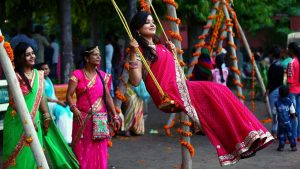
Teej, celebrated in India, falls on the third day of the waxing moon in the month of Shravan (according to the Hindu calendar) and is considered an important monsoon festival. This monsoon festival is celebrated in several states in north and west India during August and September, besides Rajasthan.
For your knowledge, Rajasthan celebrates Teej with a lot of fanfare and spectacle. As a result, there are three primary Teej celebrations: Hartalika Teej, Kajari/Kajli Teej, and Haryali (green) Teej.

The significance of this festival lies in Hindu mythology, where Lord Shiva, overcome with grief following Goddess Sati’s self-immolation, entered a deep meditative state. It is believed that it took Goddess Sati 108 subsequent births to bring Lord Shiva out of this meditative state. According to legend, Goddess Sati’s 108th birth was in the form of Parvati, which is why married women seek the blessings of Goddess Parvati during the Teej festival for marital bliss.
Teej celebrations involve women praying throughout the night and observing a fast. In the morning, they bathe and dress up to worship Goddess Parvati. The festival’s highlights include swings hung from the branches of large trees, where women take turns to enjoy them. They gather to sing songs dedicated to the festival and apply henna on their hands. Married women receive sweets and clothes from their mothers, while engaged women who are to be married receive gifts of henna, clothes, bangles, and sweets from their in-laws.

Teej is most widely celebrated in Jaipur, Rajasthan, as well as in cities in Gujarat, Madhya Pradesh, Andhra Pradesh, and Chhattisgarh. This festival is also observed in Nepal. For those interested in participating in the festivities, Jaipur is an ideal place to celebrate Haryali Teej, while Bundi is the best location to witness Kajari Teej celebrations.










